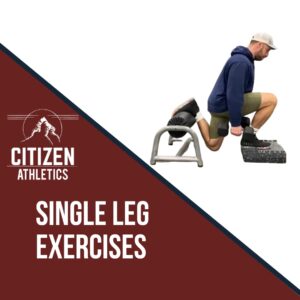Most athletes spend a large chunk of time in their sport on one leg, whether they are running, jumping, cutting, or changing direction.
As sports performance specialists and physical therapists, we need to be exposing our athletes to these types of positions and movements.
A big part of sports rehabilitation is focused on strength, making single leg exercises a crucial part of our rehab program to achieve optimal performance and promote safety of our athletes.
Here are a few of my favorite single leg exercises:
1. Reverse lunge with knee drive
This is one of my favorites because an athlete will be in this split stance position quite often during their sport when they are changing directions.
I emphasize the knee drive because it forces the athlete to work on balance and proprioception as well as helping the athlete to work towards owning the figure 4 position needed for absolute speed.
I tend to choose this exercise when my goal is to improve power and explosiveness in an athletic position rather than strength.
· Cues: Drop into the reverse lunge slow and controlled, then explode out into the knee drive making sure to get fully into figure 4 position. I like to have them hold this position for a second to really own this part of the movement before dropping back into their reverse lunge.
· Compensations: Athletes tend to rush through the exercise to decrease the load, may not go into their full ROM on the lunge, or may not hold at the top figure 4 position.
Figure four is an important position for absolute speed.
Owning this position helps athletes achieve optimal running mechanics creating a more synchronized cyclic running pattern and optimizes the vertical force you can put into the ground while decreasing ground contact time and energy leaks to maintain top end speed.
2. RFESS
Another one of my favorites because of the versatility of the exercises and tends to be slightly more challenging than a reverse lunge for most athletes.
The RFESS – Real Foot Elevated Split Squat – can be made more hip or knee dominant, depending on goals, needs and positional tolerances.
You can also slow down or speed up tempo to facilitate greater adaptations in hypertrophy or power.
This exercise challenges both legs: the front leg is challenged as it is taking most of the load and the back leg is challenged as the quad lengthens under tension.
· Cues: For more hip dominant, cue your athlete to place the front foot further out and drop straight down. For more knee or quad dominant, cue your athlete to keep their front foot closer and drop down driving their knee over their toes
· Compensations: Athletes may cheat this by making it hip dominant if they are weaker in their quads and vice versa. They may also have an increased trunk lean forwards which decreases the load on the quad. As the athlete fatigues, they may start to decrease the range of motion to make the exercise easier.
3. Pistol Squats
This exercise is one of the best indicators of relative strength and I use it a lot to determine if an athlete is ready for running.
I typically like to see an athlete able to complete a set of 10 on their injured leg getting to about 90 degrees before I start any kind of running program.
Using a dumbbell or plate can help to act as a counterbalance if they are struggling. You can modify this if the exercise is too hard by having the athlete work through less range of motion or have them lower on 1 leg but stand with 2.
If you need to increase the difficulty, try adding weight to the squat, slow down the tempo of the exercises or increase the depth.
· Cues: Perform the movement slow and controlled, lightly tap the box and come back up. Don’t fully sit down
· Compensations: As the athlete fatigues, they may rush through the movement or begin to fully sit on the box at the bottom. Athletes may also demonstrate excess trunk lean, a hip drop, or valgus knee with the motion.
The expression of single leg strength is essential for both sprinting, running, jumping, and changing direction.
Deficits in single leg strength have been shown to put athletes at greater risk of injury. Incorporate single leg exercises into your training on a weekly basis for optimal results!
Author:
Alyssa Semones, PT, DPT, CSCS is a performance physical therapist at Healthy Baller Physical Therapy, former Division 1 Lacrosse player, and three sport high school athlete. In addition to her in-person practice, she enjoys dispelling common myths, writing about sports rehab, and long relaxing walks on the beach.
Instagram: @alyssasemones.dpt


